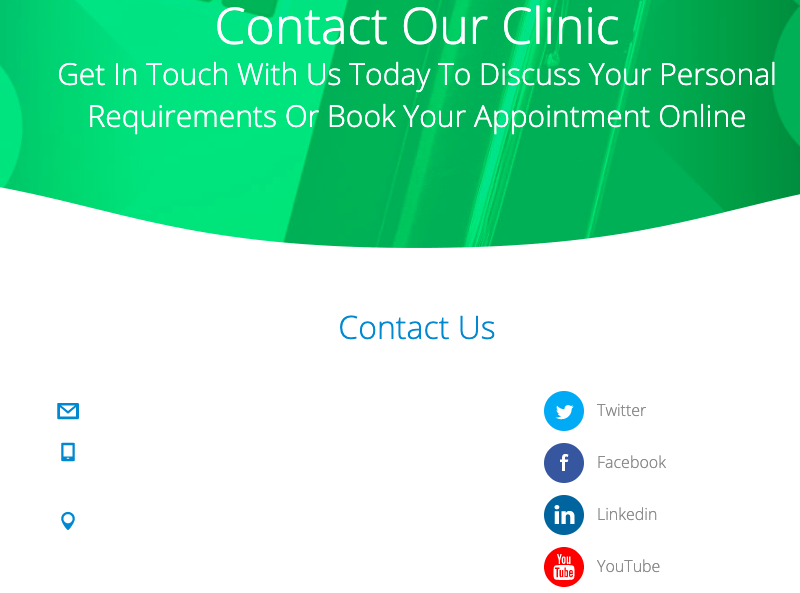
When you visit the website of one of your more successful competitors, you are likely to notice that they have a blog. There’s a good reason for this. Having an articles section on your website can serve various purposes and it certainly won’t hurt to start one. Above all, your articles will help you to generate additional traffic to your website from search engines. It’s easy to imagine a potential patient falling ill and searching for their symptoms on Google. If they were to find some answers on your site, then it’s likely that they’ll choose your clinic for treatment. That’s far from the only benefit of a blog, so let’s see how else you can take advantage.
Learn how to simplify your practice workflow and free up more time for patients with Medesk.
Open the detailed description >>What’s the Point of Starting a Blog?
It makes sense that a patient searching on Google for “gastroenterologist London” is going to be “warmer” than one who is asking “Why does my stomach hurt?”. That’s exactly why it’s worth concentrating on requests that are more viable from a financial perspective. However, once you’ve already sorted out pages for specific services and clinicians, it’s time to think about the following points:
- Patient retention
- Minimising doubts
- Demonstrating expertise
- Strengthening your image
- Increasing patient trust and loyalty
A blog will help you deal with all of the above issues. You can split them into three categories: reputational, commercial, and technical. While it’s important to realise that each of these has an influence on your revenue, the commercial topics are the ones that involve the use of expert content to engage patients in the sales funnel. Let’s start by examining each category separately.
Build Your Clinic a Better Reputation with Blog Articles
Practice managers often think that the best way to improve their practice’s reputation is to constantly broadcast how good the company is and how much it has achieved. Such content usually gets published in the “News” section where you can wait for months and not see anyone step foot on the page. Even in the best-case scenario, people aren’t interested in this information. In fact, it’s most likely that people find your self-congratulatory tone simply irritating. This faux-pas is made even worse when you add links to such pages in your newsletters. Whatever you do, don’t do that!

You ought to be focusing all your attention on your patients. Speaking of which, no one ends up on your website because they want to know which events you’ve attended recently. Patients are only interested in how you can solve their medical problems.
Medesk helps automate scheduling and record-keeping, allowing you to recreate an individual approach to each patient, providing them with maximum attention.
Learn more >>You can see that the blog shown here demonstrates how patients are cared for. There are case studies, information about services, and answers to frequently asked questions.


This is exactly the kind of content that will help you to win the loyalty of your existing patients, become an expert in the eyes of your website visitors, and improve the reputation of your clinic and its practitioners. Patients will know for sure that you can help them when they fall ill.
Your blog is your brand’s mouthpiece, so use it to speak to your readers about what interests them most. That’s how you get more patients to react to your content.
Don’t forget to add your social media buttons to your blog so that visitors can share the content they liked and you end up with a wider audience for your brand.

Turn Your Blog into Part of Your Clinic’s Sales Funnel
Posting expert articles on topics that interest your audience will help you to push patients through the sales funnel and retain them as your ambassadors through word of mouth. You may have heard about the marketing “rule of 7”. Your blog could represent the first of these seven touches, so it’s your job to increase the number of touches and convert visitors into patients. You can do so by means of the following tools:
1. Include subscription forms in articles
If your content is sufficiently useful, then you’ll find people who want to sign up to stay updated. This means you’ll have a loyal readership that will be much easier to convert to patients than non-readers.
2. Re-targeting a.k.a. Remarketing
You can configure ads on social media to follow those who have visited your blog section. For instance, someone who has read your article on overbite is probably going to be interested in your clinic’s orthodontic services.
3. Re-linking
To hasten a visitor’s progress along the sales funnel, you need to add promo blocks and links to sales-oriented pages in the text of your articles. Let’s say someone has landed on your site in search of a solution to a particular health problem and then finds out from your blog that one of your specialists can help. It makes absolutely no sense to force this person to trawl through your site until they find a booking form. By making this process involve so much effort, all you end up doing is driving people away. Make sure you place a link on every blog article for patients to book an appointment. You can use the Medesk platform to let patients pick their own time slots on a live calendar. Patients no longer have to be limited to leaving their phone number in the hope of a callback, all the while investigating which of your competitors can offer a quicker booking process. Instead, your patients will be able to choose their preferred time and date. That’s how you convert a blog reader into a new patient in one fell swoop.
Discover more about the essential features of Medesk and claim your free access today!
Explore now >>You can also add online booking links to re-targeting ads and your clinic’s social media posts.
Your Practice Blog as an SEO Tool
SEO specialists can’t deny that search engines have a preference for sites that show some signs of life. A blog allows you to kill two birds with one stone as you can inform patients about your doctors, state-of-the-art equipment, and treatment methods, all the while showing Google’s bots that your site is alive and kicking. In addition:
- Your site’s visitor count grows due to requests for information. Some traffic might not represent your exact target audience but there are ways you can warm these prospects up.
- Improve behavioural factors and re-link (again). By clicking on internal links in your articles, your visitors will spend longer on your site. This tells search algorithms that your site is interesting and should rank more highly in the search results.
What to Write on Your Blog
Before you think about what to write, decide who is going to represent your target audience and why. It will become clear what you should write and how it ought to help your business. Consider the different situations below.
Prospective patients who are unfamiliar with you
Your Task: Widen your funnel
How:
- Make it so that as many people as possible find out about you and how you can help them (now or in the future)
- Motivate people to talk about you, thus attracting even more people to your website and practice
What to Write About:
- Questions and answers on relevant topics
- “Seasonal” articles, e.g. cold and flu in colder months, the dangers of sunburn during the summer
- Symptoms and what they mean
- Advice, e.g. which type of pillow to sleep on in order to reduce back pain
- Questions “for dummies” about procedures and investigations
- Myth-busting
- Viral content that people will want to share, e.g. “Scientists have discovered a gene that promotes a longer life”, interesting facts about famous doctors, diseases etc. This approach can be a slippery slope, though, so it’s best to use it in small doses and inject it with your own brand of humour

For prospective patients who have heard of you
Your Task: Boost trust
How:
- Demonstrate expertise
- Give reasons why patients should trust you
What to Write About:
- Articles about new developments in your speciality, including treatment methods and the use of equipment and technology. Make the point that you employ the latest diagnostic and treatment methods
- Success stories containing photos of satisfied patients (with their consent, of course)
- Interviews with doctors and other staff. You should give your clinic a human face.
For prospective patients who trust you
Your Task: Inspire them to book an appointment
How:
- Alleviate fears;
- Attract with incentives
- Talk about the patient journey
What to Write About:
- Problems and their solutions, e.g. what to do in the case of post-operative complications. Show patients that you aren’t indifferent to their fears and that you can solve their problems.
- Checklists for use when preparing for appointments or procedures
- Things to do before patients come in for investigations
- Overviews of medications and equipment used in your clinic
- Articles on the importance of early diagnosis

For existing patients who have already attended an appointment with you
Your Task: Retain the patient and turn them into a brand ambassador
How:
- Show you care
- Explain the benefits of associated services
What to Write About:
- Advice on food during post-op
- Instructions on how to make an insurance claim
- How to understand test results (i.e. advising patients to see their doctor)
- Reminders, e.g. how to care for your braces
Sources of Content Ideas:
- Questions that people ask your receptionists over the phone
- Google Trends
- Search suggestions
- Competitors’ blogs
- News sites
How to Make Your Practice Blog Even More Effective
So you’ve created a dazzling blog where you only post things that’ll interest your patients. All of your articles shed light on relevant issues, are well-written including attractive illustrations and photos, and even have a commercial leaning in the form of online booking links, re-linking and so on. You have a conspicuous subscription form, social media buttons and even the option to leave comments. If all of the above is true, then your blog is already better than those of 99% of your competitors. Nevertheless, you can do better!
Learn how to simplify your practice workflow and free up more time for patients with Medesk.
Open the detailed description >>You should think of your blogs as seeds to sow. There are loads of different channels through which you can distribute your content, whether paid or free:
- Social media groups relating to your clinic — free;
- Social media groups focusing on a particular topic — can be free depending on the group;
- Guest posts for bloggers — paid, the amount being negotiable but very rarely free;
- Forums, mass media, blogs and information portals dedicated to a specific topic — both free and paid options exist;
- Review platforms — some are free, others not;
- Question and answer services — e.g. Quora, where you can track questions and answer them using your own content or excerpts thereof;
- YouTube channels;
- Regular email newsletters for subscribers;
- Targeted ads — for interested audiences and those who have visited your website.
Produce varied content, including video, photos, and infographics. You can even use a comic book style to better connect your audience with your clinic’s brand. People will share your content and attract new patients to your clinic.It’s crucial that your blog posts are optimised to answer the queries that people are searching with. If no one is looking for an answer to a given question, then there’s no point writing about it.
The best-quality content is generated when you have access to an expert on a particular topic who can fact-check your writing. This is true if you have hired a copywriter as well. Without the involvement of an expert, your clinic’s blog may end up being useless in the best-case scenario and dangerously harmful in the worst case.
Source: Entrepreneurship Life


